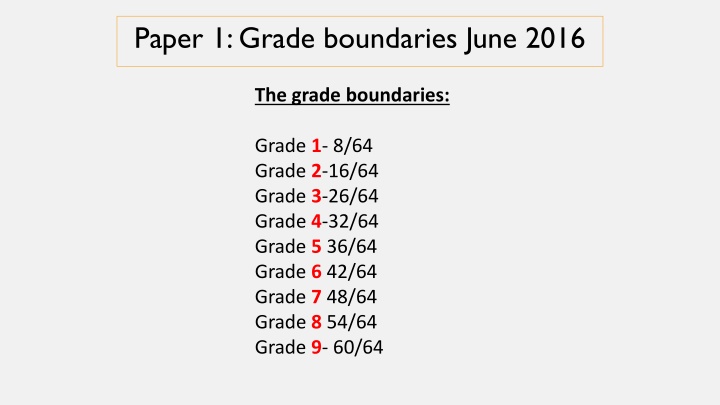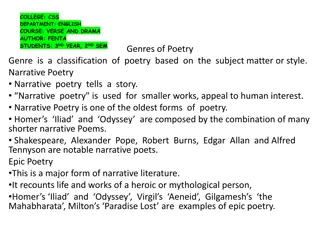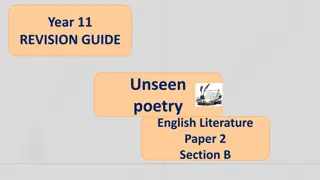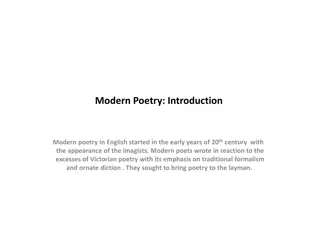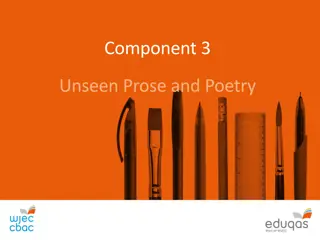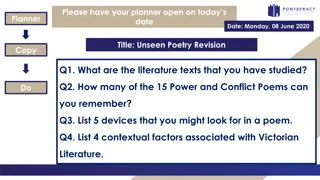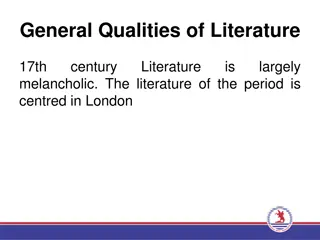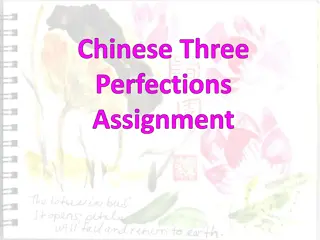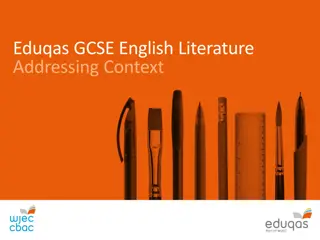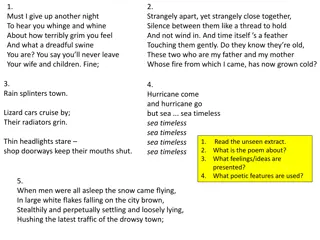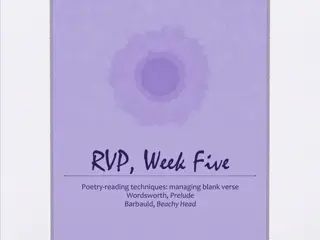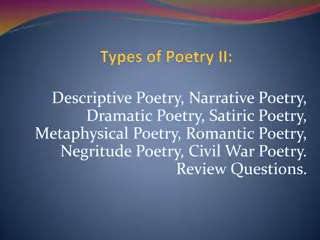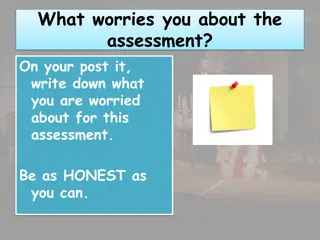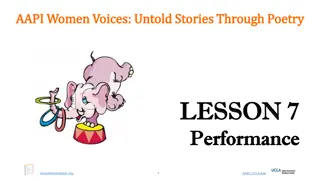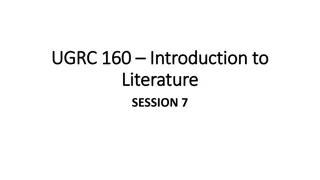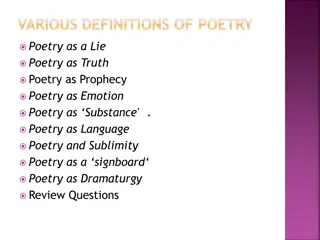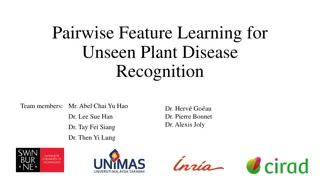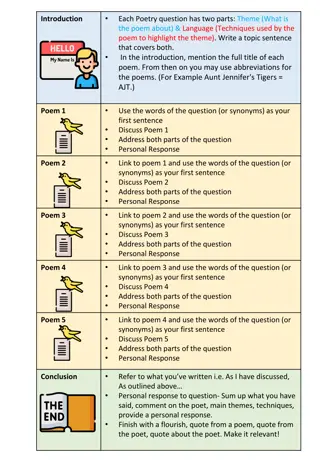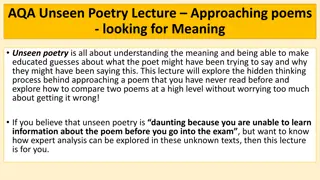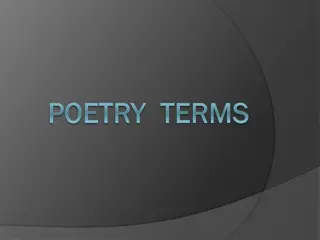Analyzing Unseen Poetry: Techniques, Themes, and Structure
Explore the nuances of analyzing unseen poetry using techniques such as imagery, alliteration, and metaphor. Understand how to decipher themes, speaker, and tone in poems for a comprehensive analysis. Learn to interpret rhyme schemes, stanzas, and structures to uncover the deeper meaning behind poetic verses.
Uploaded on Sep 24, 2024 | 2 Views
Download Presentation

Please find below an Image/Link to download the presentation.
The content on the website is provided AS IS for your information and personal use only. It may not be sold, licensed, or shared on other websites without obtaining consent from the author.If you encounter any issues during the download, it is possible that the publisher has removed the file from their server.
You are allowed to download the files provided on this website for personal or commercial use, subject to the condition that they are used lawfully. All files are the property of their respective owners.
The content on the website is provided AS IS for your information and personal use only. It may not be sold, licensed, or shared on other websites without obtaining consent from the author.
E N D
Presentation Transcript
Paper 1: Grade boundaries June 2016 The grade boundaries: Grade 1- 8/64 Grade 2-16/64 Grade 3-26/64 Grade 4-32/64 Grade 5 36/64 Grade 6 42/64 Grade 7 48/64 Grade 8 54/64 Grade 9- 60/64
UNSEEN POETRY How do I use MITSL? What is each question asking me to do? How much time should I spend on this section? What should I do in the introduction? How should my answers look? What is that 8 mark question all about?
Imagery Alliteration - the repeating of initial sounds. Assonance - is the term used for the repetition of vowel sounds within consecutive words as in, 'rags of green weed hung down...'. Metaphor - comparing two things by saying one is the other. Simile - comparing two things saying one is like or as the other. Personification - giving something non-human human qualities. Onomatopoeia - words that sound like the thing they describe. Repetition - does the poet repeat words or phrases? Senses Which are used and why? Language: What kinds of words are used? Puns - a pun is a play on words - Shear Class! if Shearer scores. Connotation - associations that words have (as "stallion" connotes a certain kind of horse with certain sorts of uses)? Double meanings - butts in - putting bottoms in or interrupting. Ambiguity - is the word or phrase deliberately unclear? Could it mean opposite things or many different things?. Word order - are the words in an unusual order why? Adjectives - what are the key describing words? Key words and phrases - do any of the words or phrases stand out? Do they shock? Are the words violent or sad etc? Slang or unusual words and misspellings - Does the poet use slang or informal language? Are American words used? Intertextuality - does the poem reference another text? Style - does the poet copy another style? (Newspaper, play etc) Characters - if there are characters how do they speak? Personal Response Complement, Criticise or say how you felt. MITSL + P Meaning what is the poem about? who is the speaker? - are they dramatized (a character) who is being spoken to or addressed? what is being spoken about? Theme(s) of the poem - what is it really about? Setting/culture- where s the poem set? Culture it is from/about? where does the poem get to from start to end? Tone How would the poem be spoken? (angry, sad, nostalgic, bitter, humorous etc) Structure Rhyme - is there a rhyme scheme? Couplets? Internal rhyme? Rhythm - how many syllables per line? Is it regular or free verse? Why are some different lengths? Stanzas - How many? How do they change? Is there a narrative? Lines - how many are their in each verse? Do some stand out? Enjambment - do the lines run on to the next line or stanza? End stopping - does each line finish at the end of a sentence? Form - does the poem have a shape to it? Caesuras Check the middle of the lines for punctuation. Always link everything to meaning. Ask yourself how does this contributes to the meaning? Why has the poet used this technique?
UNSEEN QUESTION ONE AND TWO Question One 24 marks Plan and Annotate = 5 Mins Introduction = 5 mins (The meaning part of MITSL) PEEL paragraphs = 25 mins at least 2 PEELS cover the rest of MITSL Question two 8 marks Plan 3 mins Write 2 paragraphs outlining the similarities and differences = 7 mins
In To a Daughter Leaving Home, how does the poet present the speaker s feelings about her daughter? (24 marks) Speaker s feelings about her daughter Element of MITSL
INTRODUCTION = MEANING OF THE POEM AND ANSWER THE QUESTION In To a daughter leaving home Linda Pasten tells the story of a mother and daughter relationship through the specific event of teaching her child how to ride a bike. This event acts as a metaphor for the mixed emotions the speaker feels about her daughter growing up. On the one hand she feels joy at her daughter s success but on the other hand a sense of sadness and worry at not being able to protect her daughter and losing control of the relationship. What is the poem about? What feelings are presented? In To a Daughter Leaving Home , how does the poet present the speaker s feelings about her daughter? (24 marks)
In To a Daughter Leaving Home, how does the poet present the speaker s feelings about her daughter? UNSEEN POETRY PEEL = ANSWER THE QUESTION AND COVER MITSL+P (24 marks) In To a daughter leaving home Linda Pasten presents the speaker s feelings of fear and sadness as she watches her daughter ride into the distance. These feelings are presented with use of a simile, The hair flapping/ behind you like a/ handkerchief waving/goodbye, to demonstrate how the speaker feels she is losing her daughter as she grows up. The comparison to a handkerchief confirms the link to sadness as it is associated with wiping away tears. Also the use of enjambment in this quote emphasises the speed of which the speaker feels her daughter is growing up and links to the idea that the speaker is worried that time is moving too quickly. The poet also uses a negative and fearful lexis throughout the poem, wobbled , crashed , breakable and screaming to highlight the concern the speaker has about the dangers and uncertainty her daughter will face. The presentation of fear leaves the reader feeling sympathy for the speaker because they can relate to a mother and child relationship and in my opinion the poet has successfully developed a melancholy tone to help present the paradoxical grief a parent feels at watching their children grow up. What feelings are presented? What do different elements of MITSL show? What is the reader reaction? What is my reaction?
UNSEEN POETRY COMPARISON = ANSWER THE QUESTION In To a daughter leaving home and Poem for my sister both poets use extended metaphors to present the sense of fear and concern for someone they love. Pasten using a bike as you wobbled away and Lochhead uses shoes, I wish you could stay sure footed to present the idea that the speakers are worried about their loved ones being safe. In contrast, in Poem for my sister Lochhead uses a more humorous tone to present the speaker s desire that her sister doesn t make the same mistakes she did, I try to warn my little sister about unsuitable shoes. Whereas in To a daughter leaving home Pasten presents more extreme feelings about the child s safety, I kept waiting for the thud of your crash. This perhaps emphasises the fact that maternal relationships are usually more intense. In my opinion Lochhead is more successful at presenting feelings about a loved one because her imagery and tone create a more realistic depiction of the relationship. IN BOTH POEM FOR MY SISTER AND TO A DAUGHTER LEAVING HOME THE SPEAKERS DESCRIBE FEELINGS ABOUT WATCHING SOMEONE THEY LOVE GROW UP. WHAT ARE THE SIMILARITIES AND/OR DIFFERENCES BETWEEN THE WAYS THE POETS PRESENT THOSE FEELINGS? [8 MARKS] What feelings are presented? Are they similar of different? Which is better?
IN BOTH POEM FOR MY SISTER AND TO A DAUGHTER LEAVING HOME THE SPEAKERS DESCRIBE FEELINGS ABOUT WATCHING SOMEONE THEY LOVE GROW UP. WHAT ARE THE SIMILARITIES AND/OR DIFFERENCES BETWEEN THE WAYS THE POETS PRESENT THOSE FEELINGS? [8 MARKS] Similarities Differences
Blessing The skin cracks like a pod. There never is enough water. Imagine the drip of it, the small splash, echo in a tin mug, the voice of a kindly god. Sometimes, the sudden rush of fortune. The municipal pipe bursts, silver crashes to the ground and the flow has found a roar of tongues. From the huts, a congregation : every man woman child for streets around butts in, with pots, brass, copper, aluminium, plastic buckets, frantic hands, and naked children screaming in the liquid sun, their highlights polished to perfection, flashing light, as the blessing sings over their small bones. In Oh what is that sound , how does the poet present the speaker s feelings about Poverty? (24 marks)
And I thought, just for a second, that you were me. But then I saw the woman s jacket, nipped at the waist, the ballooned jodhpurs, and of course the date, scratched in the corner. All of which told me again, that this was you at seventeen, holding a horse and smiling, not yet my mother, although I was clearly already your child. Yesterday I found a photo of you at seventeen, holding a horse and smiling, not yet my mother. The tight riding hat hid your hair, and your legs were still the long shins of a boy s. You held the horse by the halter, your hand a fist under its huge jaw. The blown trees were still in the background and the sky was grained by the old film stock, but what caught me was your face, which was mine. In Not yet my Mother , how does the poet present the speaker s feelings about his Mother? (24 marks)
